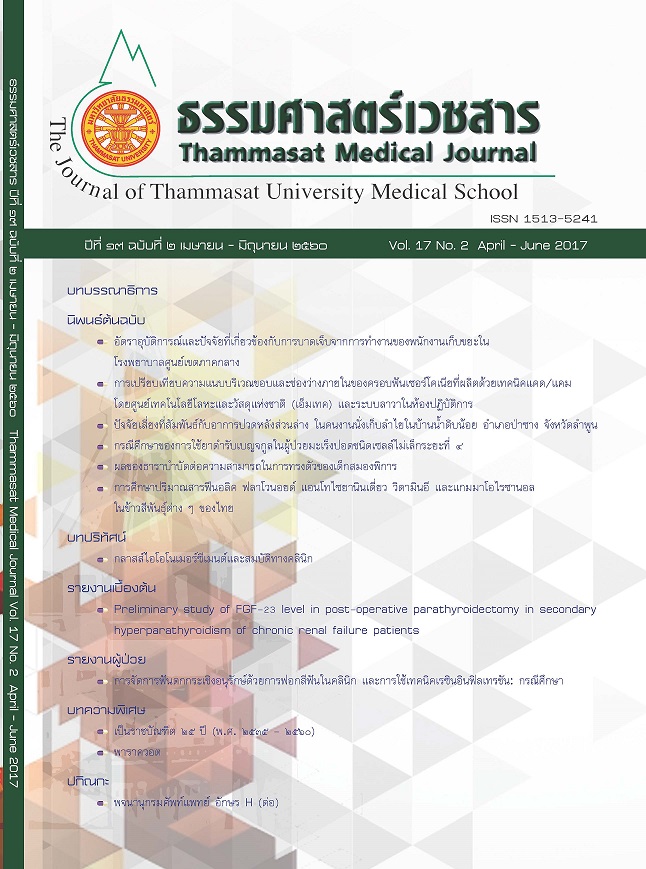Effect of hydrotherapy on balance of children with cerebral palsy
Keywords:
เด็กสมองพิการ, ธาราบำบัด, การควบคุมการทรงตัว, แนวคิดของฮัลลิวิค, Children with cerebral palsy, Hydrotherapy, Balance control, Halliwick conceptAbstract
Introduction: Hydrotherapy is used as a treatment for children with cerebral palsy. However, evidence on the effectiveness of hydrotherapy for balance control in children with cerebral palsy is limited. Objective was to investigate hydrotherapy effects on balance in children with cerebral palsy.
Method: Twenty-seven participants were children with cerebral palsy and assigned randomly into two groups: fourteen patients in the hydrotherapy groups and thirteen patients in the control groups. All participants received a physical therapy program. Moreover, participants in the hydrotherapy groups received Halliwick concept and the control groups received conventional physical therapy. All participants underwent individual session for 30 minutes/session, twice a week for 8 weeks. The participants were assessed 2 times: before and after 8 weeks. The tests included pediatric balance scale and pediatric reach test.
Result: The pediatric balance scores for both groups were statistically significant increased after training (p ≤ 0.05) and comparing between group, there was statistically significant different between group after training (p = 0.031). The pediatric reach test in right side reaching in sitting and
standing posture for both groups were statistically significant increased after training (p ≤ 0.05). In addition, only the hydrotherapy groups, the pediatric reach test in forward reaching and left side reaching in sitting and standing posture were significantly greater than that at pre-training (p ≤ 0.05). For comparing between groups, there was statistically significant difference in pediatric reach test in forward reaching and left side reaching in sitting posture and left side reaching in standing posture at post-training (p ≤ 0.05).
Discussion and Conclusion: Hydrotherapy could be increase pediatric balance scale and pediatric reach test in forward and sideward direction. Therefore, hydrotherapy may be an additional treatment for children with cerebral palsy that have a balance problem.
บทนำ: ธาราบำบัดเป็นวิธีการรักษาหนึ่งที่นำมาใช้ในผู้ป่วยเด็กสมองพิการ แต่ข้อมูลเกี่ยวกับผลของธาราบำบัดต่อความสามารถในการทรงตัวในผู้ป่วยเด็กสมองพิการยังมีอยู่จำกัด การศึกษานี้มีวัตถุประสงค์เพื่อศึกษาผลของธาราบำบัดต่อความสามารถในการควบคุมการทรงท่าในผู้ป่วยเด็กสมองพิการ
วิธีการศึกษา: ผู้เข้าร่วมงานวิจัยเป็นเด็กสมองพิการ จำนวน ๒๗ คน แบ่งออกเป็น ๒ กลุ่มโดยการสุ่ม คือ กลุ่มธาราบำบัด ๑๔ คน และกลุ่มควบคุม ๑๓ คน ทั้งสองกลุ่มจะได้รับการรักษาทางกายภาพบำบัดโดยกลุ่มธาราบำบัดได้รับการออกกำลังกายในน้ำด้วยเทคนิค Halliwick และกลุ่มควบคุมได้รับการรักษาทางกายภาพบำบัดแบบปรกติ ทั้งสองกลุ่มจะได้รับการฝึกเป็นเวลา ๓๐ นาทีต่อครั้ง ๒ ครั้งต่อสัปดาห์ เป็นเวลา ๘ สัปดาห์ โดยประเมินความสามารถในการทรงตัวขณะทำกิจกรรมต่าง ๆ (Pediatric balance scale: PBS) และความสามารถในการทรงตัวขณะเอื้อมในทิศทางต่าง ๆ (Pediatric reach test: PRT) ก่อนและหลังสิ้นสุดการออกกำลังกาย ๘ สัปดาห์
ผลการศึกษา: ความสามารถในการทรงตัวขณะทำกิจกรรมต่าง ๆ (PBS) ของทั้งสองกลุ่มเพิ่มขึ้นอย่างมีนัยสำคัญทางสถิติภายหลังการฝึก (p ≤ ๐.๐๕) และเมื่อเปรียบเทียบระหว่างกลุ่ม พบว่ามีความแตกต่างอย่างมีนัยสำคัญทางสถิติหลังสิ้นสุดการออกกำลังกาย (p = ๐.๐๓๑) ส่วนค่าความสามารถในการทรงตัวขณะเอื้อม (PRT) ไปด้านข้างขวาในขณะนั่งและยืนมีค่าเพิ่มขึ้นอย่างมีนัยสำคัญทางสถิติทั้งสองกลุ่มภายหลังการฝึก (p ≤ ๐.๐๕) นอกจากนี้พบว่าการทรงตัวขณะเอื้อมไปด้านหน้าและด้านข้างซ้ายในขณะนั่งและยืนของกลุ่มธาราบำบัดเท่านั้นมีค่าเพิ่มขึ้นอย่างมีนัยสำคัญทางสถิติ เมื่อเปรียบเทียบกับก่อนออกกำลังกาย (p ≤ ๐.๐๕) สำหรับการเปรียบเทียบระหว่างกลุ่มพบว่าความสามารถในการทรงตัวขณะเอื้อมไปด้านหน้าและด้านข้างซ้ายขณะนั่ง และเอื้อมไปด้านข้างซ้ายขณะยืนมีความแตกต่างอย่างมีนัยสำคัญทางสถิติ (p ≤ ๐.๐๕) เมื่อสิ้นสุดการออกกำลังกาย
วิจารณ์ และสรุปผลการศึกษา: ธาราบำบัดสามารถช่วยเพิ่มความสามารถในการทรงตัวขณะทำกิจกรรมต่าง ๆ และความสามารถในการทรงท่าขณะเอื้อมมือในทิศทางต่าง ๆ ดังนั้นธาราบำบัดจึงอาจเป็นวิธีการรักษาเพิ่มเติมสำหรับเด็กสมองพิการที่มีปัญหาในการทรงตัว


